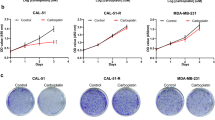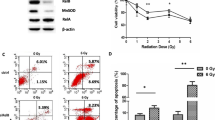Abstract
Objectives
Caffeic acid phenethyl ester (CAPE), an active component of propolis, was recently reported to have radiosensitizing effects on medulloblastoma (MB) cells. However, the mechanisms of radiosensitivity involved in medulloblastoma cells are still unclear. The specific aim of this study was to investigate the role of CAPE-induced oxidative stress to influence of radiosensitivity and anti-proliferative effects in medulloblastoma cells.
Materials and methods
Medulloblastoma (Daoy) cells were treated with CAPE in different concentrations and assessed for cell viability. The following were also evaluated: migratory ability, reduced glutathione (GSH) level, reactive oxygen species (ROS) level, nuclear factor-kappaB (NF-κB) activity, and apoptosis in CAPE alone, radiation alone, or radiation combined with CAPE in Daoy cells.
Results
The results indicated that CAPE inhibited the growth of Daoy cells. CAPE treatment in Daoy cells could effectively decrease glutathione reductase and significantly increase glutathione peroxidase. Radiation-activated NF-κB was reversed by CAPE pretreatment. Finally, the result of terminal deoxynucleotidyl transferase-mediated dUTP–biotin nick end labeling assay showed that CAPE treatment can enhance radiation-induced apoptosis in Daoy cells.
Conclusions
Our study demonstrated the anti-proliferative and radiosensitizing effects of CAPE on MB cells, which may be achievable through depleting GSH, increased ROS activity, and inhibiting NF-κB activity.





Similar content being viewed by others
References
Aggarwal BB (2004) Nuclear factor-kappa B: the enemy within. Cancer Cell 6(3):203–208
Ahmed KM, Li JJ (2007) ATM-NF-kappaB connection as a target for tumor radiosensitization. Curr Cancer Drug Targets 7(4):335–342
Bhimani RS, Troll W, Grunberger D, Frenkel K (1993) Inhibition of oxidative stress in HeLa cells by chemopreventive agents. Cancer Res 53:4528–4533
Burdock GA (1998) Review of the biological properties and toxicity of bee propolis (propolis). Food Chem Toxicol 36:347–363
Cervoni L, Cantore G (1995) Medulloblastoma in pediatric age: a single institution review of prognostic factors. Child’s Nerv Syst 11:80–85
Chen JH, Shao Y, Huang MT, Chin CK, Ho CT (1996) Inhibitory effect of caffeic acid phenethyl ester on human leukemic HL-60 cells. Cancer Lett 108:211–214
Chen MF, Wu CT, Chen YJ, Keng PC, Chen WC (2004) Cell killing and radiosensitization by caffeic acid phenethyl ester (CAPE) in lung cancer cells. J Radiat Res 45:253–260
Chiou SH, Kao CL, Lin HT, Tseng WS, Liu RS, Chung CF, Ku HH, Lin CP, Wong TT (2006) Monitoring the growth effect of xenotransplanted human medulloblastoma in an immunocompromised mouse model using in vitro and ex vivo green fluorescent protein imaging. Child’s Nerv Syst 22(5):475–480
Coffey RN, Watson RW, Hegarty NJ, òNeill A, Gibbons N, Brady HR, Fitzpatrick JM (2000) Thiol-mediated apoptosis in prostate carcinoma cells. Cancer 88:2092–2104
Dennis M, Spiegler BJ, Htherington CR, Greenberg ML (1996) Neuropsychological sequelae of the treatment of children with medulloblastoma in infants. J Neurooncol 29:91–101
Fesen MR, Pommier Y, Leteurtre F, Hirogushi S, Yung J, Kohn KW (1994) Inhibition of HIV-1 intergrase by flavones, caffeic acid phenethyl ester (CAPE) and related compounds. Biochem Pharmacol 48:595–608
Fitzpatrick LR, Wang J, Le T (2001) Caffeic acid phenethyl ester, an inhibitor of nuclear transcription factor NF-kB, attenuates bacterial peptidoglycan polysaccharide-induced colitis in rats. J Pharmacol Exp Ther 299(3):915–920
Grunberger D, Banerjee R, Eisinger K, Oltz EM, Efros L, Caldwell M, Estevez V, Nakanishi K (1988) Preferential cytotoxicity on tumor cells by caffeic acid phenethyl ester isolated from propolis. Experientia 44:230–232
Guarini L, Su ZZ, Zucker S, Lin J, Grunberger D, Fisher PB (1992) Growth inhibition and modulation of antigenic phenotype in human melanoma and glioblastoma multiforme cells by caffeic acid phenethyl ester (CAPE). Cell Mol Biol 38:513–527
Habrand JL, Crevoisier R (2001) Radiation therapy in the management of childhood brain tumors. Child’s Nerv Syst 17:121–133
Hoppe-Hirsch E, Brunet L, Laroussinie F, Cinalli G, Pierre-Kahn A, Renier D, Sainte-Rose C, Hirsch JF (1995) Intellectual outcome in children with malignant tumors of the posterior fossa: influence of the field of irradiation and quality of surgery. Child’s Nerv Syst 11:340–346
Huang ZA, Yang H, Chen C, Zeng Z, Lu SC (2000) Inducers of gamma-glutamylcysteine synthetase and their effects on glutathione synthetase expression. Biochim Biophys Acta 1493:48–55
Iwanaga M, Mori K, Ilda T, Urata Y, Matsuo T, Yasunaga A, Shibata S, Kondo T (1998) Nuclear factor kappa B dependent induction of gamma glutamylcysteine synthetase by ionizing radiation in T98G human glioblastoma cells. Free Radic Biol Med 24(7–8):1256–1268
Jaiswal AK, Venugopal R, Mucha J, Carothers AM, Grunberger D (1997) Caffeic acid phenethyl ester stimulates human antioxidant response element-mediated expression of the NAD(p)H: quinone oxidoreducatase (NQO1) gene. Cancer Res 57:440–446
Jung M, Zhang Y, Lee S, Dritschilo A (1995) Correction of radiation sensitivity in ataxia telangiectasia cells by a truncated I kappa B-alpha. Science 268:1619–1621
Kao CL, Chiou SH, Chen YJ, Singh S, Lin HT (2005) Increased expression of osteopontin gene in atypical teratoid/rhabdoid tumor of the central nervous system. Mod Pathol 18:769–778
Lee YJ, Liao PH, Chen WK, Yang CY (2000) Preferential cytotoxicity of caffeic acid phenethyl ester analogues on oral cancer cells. Cancer Lett 153:51–56
Li D, Saldeen T, Romeo F, Mehta JL (2000) Oxidized LDL upregulates angiotensin II type 1 receptor expression in cultured human coronary artery endothelial cells: the potential role of transcription factor NF-kappa B. Circulation 102:1970–1976
Lin YH, Chiu JH, Tseng WS, Wong TT, Chiou SH, Yen SH (2006) Antiproliferation and radiosensitization of caffeic acid phenethyl ester on human medulloblastoma cells. Cancer Chemother Pharmacol 57(4):525–532
Meister A (1994) Glutathione, ascorbate, and cellular protection. Cancer Res 54(7suppl):1969s–1975s
Michaluart P, Masferrer JL, Carothers AM, Subbaramaiah K, Zweifel BS, Koboldt C, Mestre JR, Grunberger D, Sacks PG, Tanabe T, Dannenberg AJ (1999) Inhibitory effects of caffeic acid phenethyl esteron on the activity and expression of cyclooxygenase-2 in human oral epithelial cells and in rat model of inflammatory. Cancer Res 59:2347–2352
Nagaoka T, Banskota AH, Tezuka Y, Saiki I, Kadota S (2002) Selective antiproliferative activity of caffeic acid phenethyl ester analogues on highly liver-metastatic murine colon 26-L5 carcinoma cell line. Bioorg Med Chem 10:3351–3359
Natarajan K, Singh S, Burke TR Jr, Grunberger D, Aggarwal BB (1996) Caffeic acid phenethyl ester is a potent and specific inhibitor of activation of nuclear transcription factor Nf-kappa B. Proc Natl Acad Sci U S A 93:9090–9095
Orban Z, Mitsiades N, Burke TR Jr, Tsokos M, Chrousos GP (2000) Caffeic acid phenethyl ester induces leukocyte apoptosis, modulates nuclear factor-kappa B and suppresses acute inflammation. Neuroimmunomodulation 7:99–105
Ozyurt H, Irmak MK, Akyol O, Söğüt S (2001) Caffeic acid phenethyl ester changes the indices of oxidative stress in serum of rats with renal ischaemia–reperfusion injury. Cell Biochem Funct 19:259–263
Rahman I, MacNee W (2000) Regulation of redox glutathione levels and gene transcription in lung inflammation: therapeutic approaches. Free Radic Biol Med 28:1405–1420
Ruan H, Pownall HJ, Lodish HF (2003) Troglitazone antagonizes tumor necrosis factor-alpha-induced reprogramming of adipocyte gene expression by inhibiting the transcriptional regulatory functions of NF-kappaB. J Biol Chem 278:28181–28192
Solovyan V, Bezvenyuk Z, Huotari V, Tapiola T, Suuronen T, Salminen A (1998) Distinct mode of apoptosis induced by genotoxic agent etoposide and serum withdrawal in neuroblastoma cells. Brain Res Mol Brain Res 62:43–55
Son S, Lewis BA (2002) Free radical scavenging and antioxidative activity of caffeic acid amide and ester analogues: structure activity relationship. J Agric Food Chem 50:468–472
Sorokina EM, Merlo JJ Jr., Tsygankov AY (2004) Molecular mechanisms of the effect of herpes virus saimiri protein StpC on the signaling pathway leading to NF-kappaB activation. J Biol Chem 279:13469–13477
Sud’ina GF, Mirzoeva OK, Pushkareva MA, Korshunova GA, Sumbatyan NV, Varfolomeev SD (1993) Caffeic acid phenethyl ester as a lipoxygenase inhibitor with antioxidant properties. FEBS Lett 329:21–24
Tamatani T, Azuma M, Motegi K, Takamaru N, Kawashima Y, Bando T (2007) Cepharanthin-enhanced radiosensitivity through the inhibition of radiation-induced nuclear factor-kappaB activity in human oral squamous cell carcinoma cells. Int J Oncol 31(4):761–768
Whelan HT, Krouwer HG, Schmidt MH, Reichert KW, Kovnar EH (1998) Current therapy and perspectives in the treatment of Medulloblastoma. Pediatr Neurol 18:103–115
Acknowledgment
This study was supported by research grants from the National Science Council (NSC-96-3111-B-075-001, 96-2628-B-010-006-MY3), Taipei Veterans General Hospital (V97E1-008, V97F-001), Yen-Tjing-Ling Medical Foundation, Taipei City Hospital (96001-62-014, 96001-62-018, 96002-62-092), and National Yang-Ming University (Ministry of Education, Aim for the Top University Plan), Taiwan.
Author information
Authors and Affiliations
Corresponding author
Additional information
Y.-Y. Lee and C.-L. Kao contributed equally to this article.
Rights and permissions
About this article
Cite this article
Lee, YY., Kao, CL., Tsai, PH. et al. Caffeic acid phenethyl ester preferentially enhanced radiosensitizing and increased oxidative stress in medulloblastoma cell line. Childs Nerv Syst 24, 987–994 (2008). https://doi.org/10.1007/s00381-008-0636-2
Received:
Published:
Issue Date:
DOI: https://doi.org/10.1007/s00381-008-0636-2




